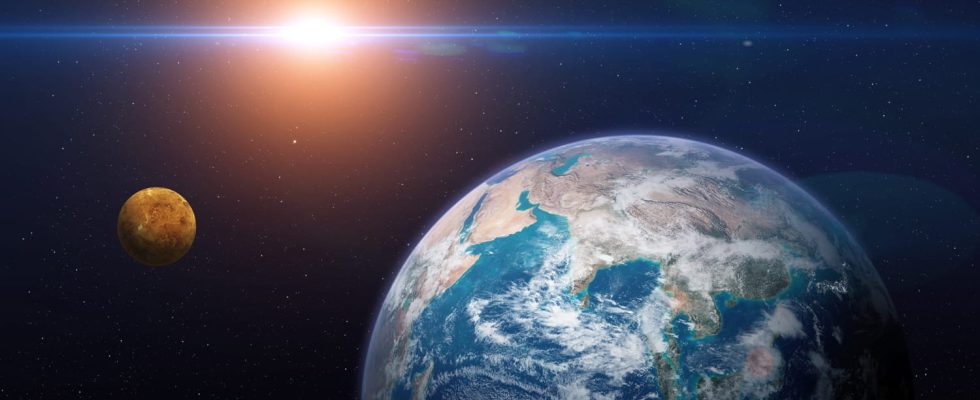ALIGNMENT OF THE PLANETS. On Tuesday evening, March 28, you will have the opportunity to attend a grand parade during which five planets will line up in the night sky. We take stock of this celestial spectacle.
[Mis à jour le 22 décembre 2020 à 17h12] Since March 25, a great planetary ballet has taken place in the night sky to the delight of astronomy enthusiasts. Jupiter planets, Mercury, Venus, Uranus and Mars are gradually approaching on the celestial vault giving the impression of aligning themselves in the sky. To make the most of the show, meet this Tuesday, March 28 in the evening, a little before sunset. It will then be possible to admire the planets alignment above the horizon for about an hour.
If the five planets seem to have given themselves the word to place themselves along an imaginary axis, this is only an optical effect. Indeed, these stars are not really aligned in the three dimensions but only gathered on one side of the Sun. Seen from Earth, the illusion is perfect and this astronomical parade remains spectacular and relatively rare. We give you all the information to take advantage of this event.
To admire the planetary alignment, the ideal moment will be this Tuesday evening, March 28th. You will then have a few hours to attend this celestial parade. Ideally, place yourself in a place where the sky is clear and spared from light pollution. You can start your observation a little before the Sun sets. You will then have an hour to admire the planets before Jupiter and Mercury disappear behind the horizon. Although some planets are visible to the naked eye, it is advisable to equip yourself with a telescope or a pair of binoculars to make the most of this parade.
To identify the different stars that will take part in the show, you can use an application like Sky Tonight (on AppStore And Google Play) or StarWalk (on AppStore And Google Play). Start by identifying Venus, also known as the Evening Star. Particularly bright, you should have no trouble recognizing it. At its side, you can find Uranus, visible through binoculars. A little higher in the sky, Mars will be the highest planet in the alignment. As you descend along the imaginary axis formed by these planets, you should come across Jupiter and Mercury, which will be near the western horizon.
What is the alignment of the planets?
A planetary alignment is an astronomical phenomenon that occurs when multiple planets come together on one side of the Sun. This is an optical illusion since the planets are not actually aligned in three dimensions of space. On the other hand, as they all revolve around the Sun in the same plane called the ecliptic, these planets align in the terrestrial sky.
When the stars are aligned?
Observed from Earth, the planets line up in the sky when they are on the same side of the Sun so that they are visible in the Earth’s sky. We commonly observe up to three or even four planets aligned but it happens from time to time that they are more numerous to join the show. We then speak of a grand planetary alignment or a complete grand planetary alignment if all the planets of the solar system are at the rendezvous.
When will all the planets be in perfect alignment?
It is extremely rare for all the planets in the solar system to line up in the sky. Indeed, for this it is necessary that all these stars are found on the same side of the Sun and are placed in such a way that they are visible from the Earth. This is called a complete grand planetary alignment. The last alignment of this type took place in June 2022 and the next one is scheduled for 2124. We will have to be patient!
What is a parade of planets?
While planetary alignment is an astronomical concept that refers to the fact that several planets group together on one side of the Sun, the term parade is a more familiar term to speak of the simultaneous presence of several planets in the Earth’s sky. Parry is therefore the consequence of planetary alignment. This is the spectacle observed from Earth.
When will the next alignment of the planets be?
Here are the dates of the next planetary alignments that you can admire from Earth in 2023:
- On March 28, therefore, the grand alignment of Jupiter, Mercury, Venus, Uranus and Mars takes place.
- On April 11, you can observe the small alignment of Mercury, Uranus, Venus and Mars.
- On April 24, there will be a small alignment of Mercury, Uranus, Venus and Mars.
- On May 29, the planets Uranus, Mercury, Jupiter and Saturn will form a small alignment.
- On June 17, you can admire the grand alignment of Mercury, Uranus, Jupiter, Neptune and Saturn.
- On July 26, there will be a mini alignment of Mercury, Venus and Mars
- On August 24, two successive alignments will take place during the night. This is the mini alignment of Mercury, Mars and Saturn at the beginning of the night then the small alignment of Uranus, Jupiter, Neptune and Saturn.
